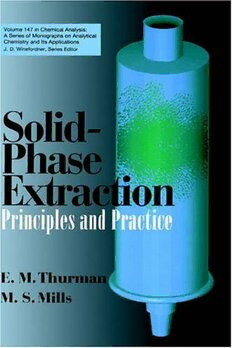Table Of ContentI.,. . -•
CHEMICAL ANALYSIS
A SERIES OF MONOGRAPHS ON
ANALYTICAL CHEMISTRY AND ITS APPLICATIONS
Editor
J.D. WINEFORDNER
VOLUME147
A WILEY-INTERSCIENCE PUBLICATION
JOHN WILEY & SONS, INC.
New York I Chichester I Weinheim I Brisbane I Singapore I Toronto
Solid-Phase Extraction
Principles and Practice
E. M. THURMAN
U.S. Geological Survey
Lawrence, Kansas, USA
M.S. MILLS
Zeneca Agrochemicals
Jealott's Hill, UK
A WILEY-INTERSCIENCE PUBLICATION
JOHN WILEY & SONS, INC.
New York I Chichester I Weinheim I Brisbane I Singapore I Toronto
This book is printed on acid-free paper. @>
Copyright© 1998 by John Wiley & Sons, Inc. All rights reserved.
Published simultaneously in Canada.
No part of this publication may be reproduced, stored in a retrieval system or transmitted in any
form or by any means, electronic, mechanical, photocopying, recording, scanning or otherwise,
except as permitted under Section 107 or 108 of the 1976 United States Copyright Act, without
either the prior written permission of the Publisher, or authorization through payment of the
appropriate per-copy fee to the Copyright Clearance Center, 222 Rosewood Drive, Danvers, MA
01923, (508) 750-8400, fax (508) 750-4744. Requests to the Publisher for permission should be
addressed to the Permissions Department, John Wiley & Sons, Inc., 605 Third Avenue, New York,
NY 10158-0012, (212) 805-6011, fax (212) 850-6008, E-Mail: [email protected].
Library ofC ongress Catologing-in-Publication Data:
Thurman, E. M. (Earl Michael), 1946-
Solid-phase extraction : principles and practice I E. M. Thurman,
M.S. Mills
p. em-(Chemical analysis; v. 147)
"A Wiley-Interscience publication."
Includes bibliographical references and index.
ISBN 0-471-61422-X (cloth : alk. paper)
I. Extraction (Chemistry) I. Mills, M.S. II. Title.
III. Series.
QD63.E88T58 1998
543' .0892:-<Jc21 97-27535
Printed in the United States of America.
10 9 8 7 6 5 4 3 2
Dedicated to Our Parents
CONTENTS
Preface xvii
Ac:knowledgments xix
( 'umulative Listing of Volumes in Series xxi
('II APTER 1 OVERVIEW OF SOLID-PHASE EXTRACTION 1
1.1. What is Solid-Phase Extraction?
1.2. How to do Solid-Phase Extraction 2
1.3. Columns and Apparatus for Solid-Phase
Extraction 4
1.4. Sorbents and Modes of Interaction 9
1.5. Applications of Solid-Phase Extraction 13
1.6. Automation of Solid-Phase Extraction 16
1. 7. Manufacturers and Bibliographies 17
1.8. History and Future of Solid-Phase Extraction 19
Suggested Reading 22
References 22
CHAPTER 2 THEORY OF SORPTION AND ISOLATION 25
2.1. Introduction 25
2.2. Synthesis of Sorbents 25
2.2.1. The Silica Particle 25
2.2.2. Bonded Phases 29
2.2.3. Polymeric Sorbents 36
2.3. Mechanisms of Sorption 38
2.3.1. Reversed Phase 38
2.3.2. Normal Phase 39
2.3.3. Ion Exchange 42
2.3.4. Mixed Mode 44
2.4. Elution of Sorbents in Solid-Phase Extraction 45
vii
VIII I '( INTI·NTS
2.4. I. Reversed Phase 45
2.4.2. Normall'hase 47
2.4.3. Ion Exchange ami Mixed Mode 48
Suggested Reading 48
References 49
CHAPTER 3 METHODS DEVELOPMENT 51
3.1. Six-Step Approach to Methods Development 51
3.1.1. What is Solute Structure? The Clue to
Effective Solid-Phase Extraction 51
3 .1.2. Identify the Goal 52
3.1.3. Obtain Physical Constants 52
3.1.4. Choose the Mechanism of Solid-Phase
Extraction 54
3.1.5. Elute the Solid-Phase Extraction Sorbent 56
3.1.6. Perform the Sorption Experiment and
Determine Breakthrough 60
3.2. Executing the Solid-Phase Extraction
Experiment in Five Steps 62
3.2.1. Step 1 63
3.2.2. Step 2 63
3.2.3. Step 3 63
3.2.4. Step 4 64
3.2.5. Step 5 64
3.3. Troubleshooting and Optimizing a Method 64
3.3.1. Problem 1: Incomplete Elution 64
3.3.2. Problem 2: Breakthrough of Analyte 65
3.3.3. Problem 3: Significant Breakthrough of
Analyte 65
3.3.4. Problem 4: Interfering Substances 66
3.4. Critically Evaluate Previously Published
Methods 67
3.5. Simple Summary of Methods Development 69
Suggested Reading 69
References 69
CONTENTS IX
t 'IIAI,TER 4 REVERSED-PHASE SOLID-PHASE
EXTRACTION 71
4.1. Introduction 71
4.2. Structure of Reversed-Phase Sorbents 72
4.3. Reversed Phase as a Partitioning Mechanism 77
4.4. Chromatographic Plate Theory and
Reversed-Phase Solid-Phase Extraction 80
4.4.1. Introduction 80
4.4.2. Theoretical Aspects of Plate Theory 83
4.5. Chromatographic Plate Theory: Its Application to
Reversed-Phase Solid-Phase Extraction 88
4.5.1. Introduction 88
4.5.2. Determining and Predicting Breakthrough
Volumes 92
4.5.3. Polarity and Breakthrough 94
4.5.4. Example Calculation of Breakthrough
Volume using k'.,. 95
4.5.5. Practical Effects of Plate Number on
Solid-Phase Extraction 96
4.6. Examples of Methods Development with
Reversed-Phase Solid-Phase Extraction 99
4.6.1. Trace Enrichment of Pesticides from
Groundwater 99
4.6.2. Extraction of Protein from Dilute Aqueous
Solution 100
4.6.3. Extraction and Purification of Synthetic
Oligonucleotides 101
4.6.4. Extraction of Indole-3-Acetic Acid 102
4.6.5. Extraction ofCatecholamines from Urine 102
Suggested Reading 103
References 104
CHAPTERS NORMAL-PHASE SOLID-PHASE
EXTRACTION 105
5.1. Introduction 105
5.2. Structure and Sorption of Normal-Phase
Sorbents 106
5.3. Elution of Normal-Phase Sorbents 1.11
X CONTENTS
5.4. Examples of Methods Development with
Normal-Phase Solid-Phase Extraction 112
5.4.1. Extraction of Aromatic Hydrocarbons
from Crude Oil 113
5.4.2. Extraction of Polychlorinated Biphenyls
from Transformer Oil 114
5.4.3. Extraction of Carotenes from Plant Tissue 115
5.4.4. Extraction of N-Nitrosoamine
(N-Nitrosopyrrolidine) from Bacon 116
5.4.5. Extraction ofAflatoxins from Corn,
Peanuts, and Peanut Butter 117
5.4.6. Extraction of Pyridonecarboxylic-Acid
Antibacterials from Fish Tissue 118
5.4.7. Extraction of Vitamin D from Serum 119
5.4.8. Extraction of Antibiotics from Ointment 120
Suggested Reading 121
References 121
CHAPTER 6 ION-EXCHANGE SOLID-PHASE
EXTRACTION 123
6.1. Introduction 123
6.2. Structure of Solid-Phase Extraction
Ion-Exchanger Sorbents 126
6.2.1. Cartridges 126
6.2.2. Disks 131
6.3. Ion Exchange as a Chemical Reaction 132
6.4. Selectivity of Ion Exchange 132
6.5. Donnan Membrane Theory 135
6.6. Law of Chemical Equilibrium and Selectivity
Coefficients 139
6. 7. Kinetics oflon Exchange 141
6.8. Methods Development: General Principles 141
6.8.1. Selecting Cation or Anion Exchange 142
6.8.2. Molecular Size and Weight 144
6.8.3. Interferences and Competing Ions 145
6.9. Methods Development Experiment 146
6.1 0. General Method for Ion-Exchange Solid-Phase
Extraction 147

